McGill news makers 2000
From McGill's perspective, the 1990s were a bumpy decade.
There were plenty of high points, of course. McGill researchers cemented their reputations as among the most productive in the country -- maybe the most productive. The University's increasingly stringent entrance requirements meant that the student body is probably as smart as it's ever been. (I graduated from McGill in 1989 and I doubt I could get into the place today with the CEGEP marks I had way back when.)
Some major new academic initiatives -- the McGill School of Environment and the McGill Institute for the Study of Canada, to name two -- got off to promising starts.
But the directors, chairs and administrative assistants who tended to budgetary matters won't be mourning the '90s anytime soon. Cut after cut after cut takes a dreadful toll on one's nerves.
In the '90s, McGill proved it could hang tough and maintain most of its quality despite declining resources (the leaky roofs and the loss of some talented professors to the brain drain notwithstanding). This past year might be remembered as a turning point in the University's history -- the year when optimism became fashionable again.
The budget cuts from Quebec City ended -- we even started to receive more money from the provincial government than we have in recent years. The remarkable $64-million donation from Richard Tomlinson will energize a number of McGill initiatives -- the University will no longer be an also-ran compared to sister institutions when it comes to funding graduate students, for instance.
Granting agencies are starting to provide more, not less, funding for research projects. New federal initiatives such as the Canada Research Chairs and the Canada Foundation for Innovation offer key support for McGill's plan to hire hundreds of talented new professors in the next decade.
Things are looking up.
McGill researchers were an active bunch in 2000, attracting a lot of attention from the media for their accomplishments.
For the third year in a row, I spent a few days sorting through hundreds of stories about McGill that appeared in different newspapers, magazines, and TV and radio shows, using some media databases (LEXIS-NEXIS, Canadian Newsdisc and NewsCan) and other sources. As a result, I've compiled a list of McGill's top ten research stories of 2000.
The stories had to mention the McGill researcher by name. The stories also had to include a reference to McGill, or to a McGill-affiliated institution, and they had to sum up the research itself.
I only counted an appearance in any single media outlet once. My list shows how often McGill researchers turned up in different media. Professor Margaret Somerville from the Centre for Medicine, Ethics and Law, for instance, appeared several times in both the National Post and The Ottawa Citizen last year. On my list, that doesn't put her any further ahead than a colleague who only turned up once apiece in those newspapers.
Before we get to our top ten, a few media appearances by McGill newsmakers were particularly noteworthy and should be singled out.
Dr Thomas Hudson, director of the McGill-based Montreal Genome Centre, was included in a cover story grouping of "Great Canadians" by Maclean's that also featured Supreme Court chief justice Beverley McLachlin and ABC News anchor Peter Jennings. According to Maclean's, Hudson is "one of the founding fathers of the much-heralded New Age research into humanity's chemical code, its genome."
Biology professor Amanda Vincent, the world's leading authority on seahorse biology and a conservationist working on an international scale to protect seahorses and other marine life from over-fishing and other dangers, was named as La Presse's Personality of the Year in Humanities and Social Sciences, Science and Technology.
US News & World Report magazine named McGill neuroscientist Dr Samuel David as one of its "Innovators 2001: The Best Minds at Work." David leads a research team that is making what was once considered impossible feasible, the creation of a vaccine-type treatment that repairs spinal cord damage and restores nerve function. The treatment has already proven to be successful on mice.
Architecture professor Avi Friedman, a pioneer in the area of creating affordable and flexible home designs to meet the needs of families that don't have the cash to buy monster mansions, was named by the trendy design magazine Wallpaper as one of "Ten Who Will Change the Way We Live." Wallpaper is the magazine that invariably features emaciated and glum-looking young people on its covers. ("You too can be depressed and anorexic -- all you need are the right furnishings.")
As for the McGill researchers who attracted the most ink overall:
1
Ray Chiu
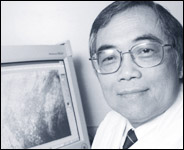 |
|
In the top spot is cardiology professor Dr Ray Chiu with 56 appearances in different media. Chiu and his colleagues studied the possible use of immature bone marrow tissue called marrow stromal cells as an approach for tending to damaged hearts. These cells are unique in that, once injected into different parts of the body, they transform themselves into new tissue that's appropriate to their new surroundings. The reason why that's important is that damaged hearts can't create new tissue to replace what's been lost as a result of a heart attack or heart disease.
The New York Times, the Los Angeles Times and CBC Radio's "As It Happens" all covered the story. Chiu told the Reporter that he is anxious to see the new therapy, done successfully on mice, tried on human subjects. "I believe it will take at least two years for this procedure to come into clinical practice. But if patients exert pressure to speed up the process, that could speed things up. I know that lots of patients with nothing to lose will volunteer for the trials."
2
Samy Suissa
In second place is epidemiology and biostatistics professor Samy Suissa. Suissa garnered 44 mentions from different media, including The Miami Herald, The Washington Post and The Toronto Star, for leading a study that concluded that asthma sufferers who regularly use steroid inhalers to treat their breathing problems lower their risk of dying from the disease. Because of concerns related to possible side effects of steroid inhalers, including glaucoma and stunted growth in children, the medications aren't as popular as they once were.
Suissa's study points to the importance of asthma sufferers using the steroid inhalers regularly once they've been prescribed. "Physicians have known all along that these medications are very effective. Now with this new data, they know they can actually save the lives of their patients," Suissa told the Associated Press.
3
Michael Meaney
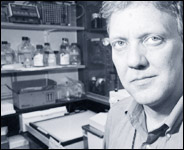 |
|
Psychiatry professor Michael Meaney places third with 42 appearances in such media as the New York Post, the Chicago Sun-Times and the National Post. Using rats, Meaney's lab concluded that nurturing enhances neural connections in the brain and improves both memory and the learning of some tasks. Rat pups that received plenty of grooming and stroking from their moms were able to perform certain tasks better.
"There is evidence for a direct relationship between maternal care and hippocampal development and spatial learning in adulthood," Meaney told EXN, the Discovery Channel's web site. "Activity of the genes is always influenced by the environment. And the most important feature of the environment for an infant is its mother."
4
Michael Kramer
 |
|
Epidemiology and biostatistics professor Michael Kramer is in fourth place. Kramer's research suggested that babies born even just a few weeks prematurely run a significantly higher risk of death in their first year than full-term babies do. While the dangers faced by babies who are born very prematurely are well known, it's not unusual for babies to be intentionally delivered a few weeks before their due dates.
Births are sometimes induced as early as 35 weeks (40 weeks is the norm for a full-term birth) for reasons of convenience such as ensuring that a favoured obstetrician will be there for the delivery before she embarks on a trip out of town. Kramer told the Associated Press that such practices are potentially far more dangerous than many obstetricians realize. His work was covered by La Presse, The Philadelphia Inquirer and CBS Radio News.
5
Roger Gosden
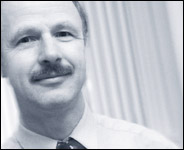 |
|
In fifth place is obstetrics and gynecology professor Roger Gosden. Gosden hopes to develop a birth control pill that would also stall the aging process of women's ovaries. While the work is in its very early stages -- Gosden says such a pill might be 15 years away -- the announcement attracted attention around the world. Thirty-six publications and broadcasters, including the San Francisco Chronicle, Le Devoir and National Public Radio's "Morning Edition," reported on Gosden's work.
"There are all sorts of social pressures for people to extend their training periods [at work] and people are settling down with partners later. Yet the biological limits of our fertility are fixed," Gosden said at a news conference. "We wonder whether there is a way to address all those issues."
6
Margaret Somerville
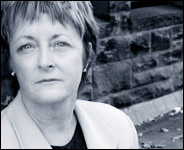 |
|
Sixth place goes to Professor Margaret Somerville from the McGill Centre for Medicine, Ethics and Law, who recently published a book called The Ethical Canary: Science, Society and the Human Spirit. In the book, Somerville deals with a variety of moral concerns related to health care and scientific developments such as cloning, euthanasia and xenotransplantation (the use of animal organs for human transplants).
"Within the last five years we have obtained the power to profoundly alter life itself," Somerville told the Reporter. "We face questions that no generation in human history has had to contend with." She hopes her work will spark a discussion about those questions. She seems to be succeeding. Thirty-two different media, including The Globe and Mail, Maclean's and CTV National News have either reported on Somerville's book or featured interviews with her about issues dealt with in the book.
7
Brian Alters
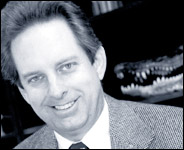 |
|
Educational studies professor Brian Alters is in seventh place. An expert on teaching and learning as it relates to the topic of evolution, Alters heads the new Evolution Education Research Centre involving scientists and education experts from both McGill and Harvard.
Despite the fact that the vast majority of scientists regard evolution as a cornerstone of biology, the general population remains largely unconvinced by Darwin's revolutionary notion.
"One out of two North Americans says evolution did not occur. They say the textbooks are wrong, the scientists are wrong, the teachers are wrong," Alters told the Reporter. Religious beliefs are part of the reason, he says, but a lot of it has to do with widespread misunderstandings about evolution. "We want to examine what's going wrong in teaching and learning here." His work was chronicled by 28 different media, including Britain's The Guardian, University Affairs and the Calgary Herald.
8
Catherine Bushnell
 |
|
In eighth spot is Professor Catherine Bushnell from the Departments of Anesthesia and Physiology. Bushnell uses brain imaging technologies to examine what's going on in our heads when we experience pain. She led a research team that concluded that the severity of pain is determined by the activation of several areas of the cerebral cortex, including those associated with our emotions.
Bushnell believes that relaxation techniques aimed at distracting patients from the source of their pain can be a very effective strategy for making the pain bearable. "You really can teach people to reduce their pain," Bushnell told The Boston Globe. The Irish Times and the Chicago Tribune also covered the story.
9
Nancy Mayo
 |
|
Epidemiology and biostatistics professor Nancy Mayo is in ninth place. She led a study that determined that those who suffered from strokes had a greater chance of full recovery if they were rehabilitated at home, instead of at the hospital. "People want to be able to climb the stairs, walk out to their patio or go back to gardening. It makes a difference when someone is trying to relearn one of those skills instead of seeing how long they can walk on a treadmill," Mayo told the Reuters news agency. Nineteen media reported on Mayo's findings, including The Denver Post, The Washington Times and Newsday.
10
Pascal Belin
Pascal Belin, a postdoctoral fellow at the Montreal Neurological Institute who works in neuropsychology professor Robert Zatorre's lab, takes tenth place. Belin was the principal author of a study that pinpointed the portions of the brain that seem to be responsible for processing information related to the voices we hear.
Using magnetic resonance imaging to monitor brain activity, Belin's team played hundreds of vocal and non-vocal sounds to research subjects. The researchers found the brain not only sets speech apart from non-human noise, but also from other sounds made by humans.
"We included handclaps, snoring, etc., to test the possibility that the areas found would respond to any sound of human origin, vocal or not, but it is not the case," Belin told United Press International. His work caught the attention of 18 different media, including USA Today, Equinox magazine and CTV's "Canada AM."
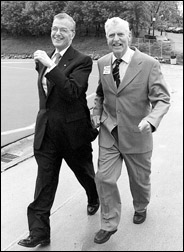 Principal Bernard Shapiro with donor Richard Tomlinson.
Principal Bernard Shapiro with donor Richard Tomlinson. |
|
McGill's biggest non-research news story of the year was the Tomlinson donation, the largest gift of its kind in Canadian university history. Twenty-four media reported on the gift, including The Chronicle of Higher Education, The Globe and Mail and the National Post. Other widely covered stories included McGill's controversial negotiations with Coca-Cola over a possible exclusivity deal for Coke beverages and a report produced by the University Planning Office that argues that Montreal has more university students per capita than any other major city in North America.
Music student Andy Creeggan garnered more press attention than any other McGill student in 2000. A former member of the Barenaked Ladies, Creeggan and his brother Jim, a current BNL member, released a well-received album, Trunks, as The Brothers Creeggan.
Creeggan told the Reporter why he quit the BNL, one of the planet's most popular bands. "Your world gets huge all of a sudden and for someone who never really desired that, it was unnerving sometimes. I wanted space for my music, my personality, and I'd never been to school. I was afraid I'd be boxed in staying with the Ladies."
 Pierre Trudeau's sons, Justin (top) and Sacha, came into the media spotlight this year. Both attended McGill.
Pierre Trudeau's sons, Justin (top) and Sacha, came into the media spotlight this year. Both attended McGill.PHOTO: Adran Wyld: CP Picture Archive |
|
As far as alumni go, the McGill graduates who received the most coverage in 2000 were Justin and Alexandre (Sacha) Trudeau, the sons of the former prime minister whose death was unquestionably one of the most significant events to take place in Canada last year.
The Trudeau sons received widespread acclaim for their dignified and graceful response to the sorrow their father's passing caused from coast to coast. Alexandre is a promising filmmaker, while Justin is a history and drama teacher. Justin's moving eulogy even sparked much speculation amongst media pundits that he might be destined for his dad's old job -- a notion that seems more than a little premature in retrospect.
Other McGill graduates who turned up in the news often: the CBC's Mark Starowicz, the force behind the network's surprisingly popular "Canada: A People's History"; John McCallum, the former McGill dean of arts and Royal Bank vice-president who is a good bet to be added to Jean Chrétien's cabinet; Darren Entwhistle, the new president and CEO of Telus Corp, a telecommunications company gearing up to challenge Bell Canada; McGill chancellor and powerful International Olympic Committee member Richard Pound; and actor William Shatner, who is enjoying a resurgent career by poking fun at his own reputation for over-the-top acting, pomposity and tortured singing in movies like Free Enterprise, TV shows like Third Rock From the Sun and commercials for Priceline.com.

